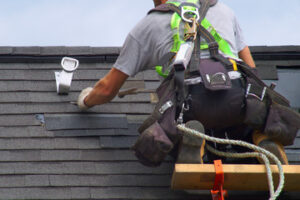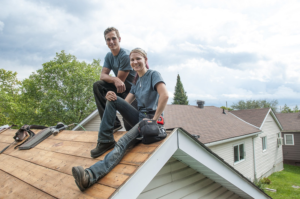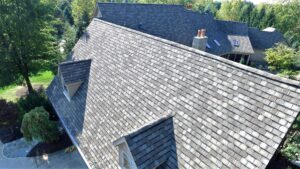A well-maintained roof protects homeowners from both obvious threats like weather events and falling trees, and less-obvious ones such as excess moisture that leads to mold and energy inefficiency that compromises indoor comfort. A good roofing maintenance plan includes regular inspections, gutter cleaning and re-caulking to catch issues before they become major problems.

The shingles on your roof are the first line of defense against the elements, keeping water and other debris from penetrating your home, which can lead to costly structural damage over time. However, like all roofing materials, they are not indestructible and will need to be replaced eventually. Proper maintenance and occasional restoration can extend the lifespan of your shingle roof, significantly reducing the cost of repairs or replacement. Visit https://www.jmelitecontractors.com to learn more.
Asphalt shingles are the most common roofing material, and one of the most affordable. They are also easy to install, and with a variety of styles, colors, and textures, they can add to your home’s visual appeal as well as provide protection. It is important to regularly inspect your shingle roof for any signs of wear and tear, including a curling or buckling that can leave your roof vulnerable to water damage.
It is also important to look for moss or algae growth on your shingles. This can be unsightly, but it is more importantly a sign that moisture is not draining properly from the attic. It is recommended that you have a professional clean your shingles once every two years to remove any buildup and keep your roof looking its best.
Another area of the roof that should be carefully inspected during a shingle maintenance inspection is the valleys. These are the areas where the roof faces meet, and it is crucial to have proper valley metal installed to prevent leaking. Older shingle roofs often lack this, and the shingles will begin to weep. It is a good idea to have these valleys resealed with a waterproof sealant at least once per year.
If your shingle roof is older, it may be wise to have it resealed every one to three years. This will help to protect the shingles from the sun’s UV rays and keep them water-resistant.
It is also a good idea to inspect your gutters and downspouts for any obstructions or damage. Clean and well-maintained gutters and downspouts are important to directing water away from the roof and home, which will help to extend the life of your shingle roof.
Flashing
Flashing is a critical piece of roofing that helps prevent long term water damage in the roof area. It acts as a barrier to prevent moisture from getting in through joints where the roof meets walls or other protrusions like chimneys and vent pipes. Without the proper flashing in place, this moisture can penetrate the roof and cause wood rot, mold and other structural damage to the home.
There are many different types of flashing, and the best type for any given situation is custom fabricated by a metalworker to fit the specific job site. The most common type is step flashing, which is used where the roof meets the wall. This consists of multiple rectangles of sheet metal bent into an “L” shape, with the base nailed to the roof and the top secured to the wall. These steps are then covered by shingles, and any gaps or holes are sealed with caulking.
Other types of flashing include valley flashing, which is installed where two roofs meet at a slope; coping flashing, which covers the underside of a ridge cap to protect it from rain; and sill flashing, which is embedded in wall interruptions to prevent water ingress or direct water that has already entered back outside. There is also through wall flashing, which spans the thickness of the wall to direct water into weep holes; and cap flashing, which is used above windows and doors.
While it is possible to install flashing yourself, the delicate and specialized nature of this work should always be left to a professional roofing company, like Cloud Roofing. These professionals will ensure the flashing is properly fabricated and sealed to prevent leaks and other water damage in the roof area.
Flashing is a critical part of any roofing system, and should be inspected regularly for damage or wear. The longer you wait to have it repaired, the more costly a repair will be and the more likely your roof is to sustain serious damage that will require substantial repairs. Regular inspections can help identify potential problems early and get them repaired quickly.
Gutters
Gutters are a critical component of any roofing system. They are responsible for directing water away from the roof and home, preventing it from pooling on the roof and causing damage. They also help to preserve fascia and soffit, prevent soil erosion and basement flooding, and maintain roof and foundation integrity. Gutters should be cleaned regularly to ensure they are functioning properly.
Regular gutter maintenance can significantly extend the life of a roof, as well as improve a building’s overall structural integrity. Clogged or damaged gutters can cause water to overflow and accumulate on the roof, resulting in premature deterioration of roofing materials. Additionally, wet environments encourage the growth of mold and mildew, which can further damage the roof’s structure and lead to leaks and other problems.
Rain gutters are typically installed on the eave of a roof and are connected to downspouts. These downspouts then direct the collected water either into a yard, waste system, or somewhere else far away from the house. Gutters are made of various materials and come in a variety of styles, but they all serve the same purpose of gathering and diverting rainwater.
Gutter cleaning is a crucial part of roofing maintenance and should be done at least twice per year, in the spring and fall. While some people choose to clean their own gutters, it is often best to leave this task to a professional. Not only is climbing a ladder dangerous, but improper gutter cleaning can result in additional damage to the system.
The importance of gutters cannot be overstated. While protecting the roof is a significant function, gutters are also instrumental in preserving the foundation of a home, avoiding basement flooding and soil erosion, and improving a building’s aesthetics and value. Keeping your gutters clean and in good condition is a simple way to protect your investment and ensure the longevity of your roof. Invest in a quality gutter system, and make sure to schedule regular inspections with a Birdcreek Roofing professional. You’ll save money in the long run by catching any issues before they become costly repairs.
Soffits
While they may appear as simple architectural elements along the eave of your roof, soffits and fascia play pivotal roles in ensuring the integrity and functionality of your home’s roofing system. Soffits, found beneath the eaves, protect the rafters and joists of your roof from moisture-related damage, and they keep pests like rodents and birds away from the attic. Fascias, which are attached to the ends of the rafters, serve as an effective barrier against water and moisture from seeping into your attic, causing rot and other structural damage.
Soffits are made of a variety of materials, including wood, aluminum, and vinyl. They can either be vented or non-vented, depending on your home’s ventilation needs. Vented soffits consist of small holes that allow air to flow into the attic and regulate the temperature in your home. Non-vented soffits, on the other hand, serve as insulation and can be sealed and painted with an exterior-grade paint or stain.
Both types of soffits should be inspected regularly for signs of damage, moisture, or pest infestation. Visible decay, water stains, peeling paint, or mold growth are all indicators of moisture infiltration. Bird droppings, rodent nests, or chew marks on the soffit can also indicate an infestation. If you find any of these issues, it is important to hire a reputable roofing contractor to make the necessary repairs and protect your home from further damage.
Keeping soffits free from leaves, debris, and other contaminants will prevent moisture-related problems and extend their lifespan. Performing regular visual inspections, using a soft-bristled brush to remove any dirt or dust buildup, and sealing all open joints with caulk are all effective methods for maintaining your soffits. Keeping your soffits clean will also ensure proper airflow and prevent water penetration.
If you notice any signs of soffit damage or deterioration, contact a professional roofing contractor to perform repair or replacement. Experienced contractors have the knowledge, skills, and equipment necessary to properly assess soffit damage, recommend appropriate repairs, and execute the work safely and efficiently. They will also ensure that all damaged areas are thoroughly cleaned and protected with a high-quality exterior-grade sealant to extend their lifespan.


